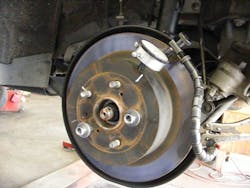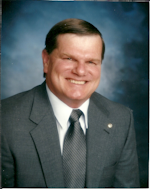Tools Used
Brake wear gauge
Scan tool
Vehicle information
Brake fluid tester or test strips
Dial indicator
Torque wrench
Torque stick or socket
Brake hub polisher
Brake bleeder screw repair kit
Vehicles affected - All
It seems like the simpler, or more routine a repair is, the easier it is to make errors that affect the outcome of a quality repair. These errors, mostly due to technician complacency or poor quality control, will most likely influence your customer’s perception of your shop and, just as important, your bottom line. In this month’s Tool Briefing, we will discuss how you can take a little extra time (and use the right tools) to help ensure vehicles are being repaired correctly. With this in mind, you are more likely to reduce customer come-backs, while maintaining productivity and profitability.
Common issue 1 – Improper brake inspection practices.
Any complete repair begins with a proper diagnosis – and brake work is no exception. Many technicians will inspect brakes by using a wear gauge such as the GearWrench 3962 wear indicator set. These gauges will give the technician an accurate measurement of the brake pad thickness. The problem with using these tools is many technicians do not remove the wheels or the calipers from the vehicle. Even though the technician can measure the brake pad thickness with the wheels on, removing the wheels and the calipers will allow the technician to identify any additional faults present in the brakes.
When a technicians removes the wheels and calipers, he or she can then visually check for uneven wear, measure the rotor thickness, and/or determine if the pads or rotors have any cracking or heat related issues. They can also determine if any leaks are present.
Another error I have seen technicians make is to not remove the rear wheels and check the rear brake system, especially with vehicles that use drum brakes in the rear. This is mainly due to the technician’s experience that rear brakes do not wear at the same rate as the fronts. Even though that is true, rear brakes still wear and require periodic inspection and adjustment. Additionally, rear parking brakes will wear and require service, including rear disc systems which may need both a caliper/pad adjustment and an inspection of the rear parking brake shoes, which will necessitate removing the rear rotors.
Another often overlooked part of a brake inspection is to connect a scan tool to determine if any codes are present in the ABS or traction control systems. Any codes will indicate an issue that needs further inspection. Along with scanning the system, use your vehicle information database to check for any TSB’s and for updated service maintenance procedures.
It is also critical to check the brake fluid with either a test strip or an electronic tester such as the OTC 4598 DOT 3 tester, or the Cal-Van Tools No. 66 tester which tests all brake fluids for contamination.
Each of the above steps is necessary to provide both you and your customer with an accurate analysis of their brake system.
Common issue 2 – Vehicle has vibration after brake service.
This complaint is very common in recent years since many shops routinely replace brake rotors rather than use a brake lathe to surface them. The cost of replacement rotors has dropped significantly ever since imported parts became readily available, so many shops choose to replace, rather than surface, rotors.
One potential issue with these rotors is that during shipping they may have been stored on their side, rather than flat, which can cause them to warp. Other possible defects of new rotors include imperfections in the surface that meets the hub, or variances in the thickness of the rotor. A technician can detect such conditions by spending a few moments during the installation process using a dial indicator, like the Steelman 60378, to test for run-out. Many shops go on to install rotors without checking the run-out, or might even fail to measure the rotor to assure it meets size specifications. We have even seen some instances where a rotor met the run-out and size specifications, but the offset of the hub flange was incorrect, which would cause the caliper to rub on the rotor.
The easy fix for these issues for us was to switch to purchasing only high quality rotors. Even then we spend a few extra moments during the installation process to measure tolerances. Although it takes a few minutes, the likelihood of having a come-back, which will take significantly longer to correct, is greatly reduced.
It is important to remember with many of today’s vehicles, brake vibrations are not only a nuisance, but may also cause other issues. Vibrations caused by brake rotors, wheel hubs, or tires can cause both stability control and ABS issues and, in some cases, cause false misfire codes. Yes, a misfire code! The strategy some vehicle manufacturers use is to monitor wheel speed sensors for variations (skipping) when the torque converter is locked. Unless the vehicle is on a rough road, these variations could be signs of the engine misfiring.
Other common errors that can cause brake vibration but are easily remedied by spending a few minutes with the right tools are:
Wheels not torqued properly – Use vehicle information to obtain the correct torque specification, then use a torque wrench or torque stick, such as the Ken Tool 30180, to tighten correctly. You should also tighten wheels in a cross pattern rather than a circular pattern.
Hub and/or rotor surfaces not cleaned – Use a hub polishing kit such as the Steelman 99905 polisher to clean both surfaces, allowing the rotor to sit flush to the hub face.
Common issue 3 – Brakes are noisy after brake service
This is another somewhat common issue that can occur after replacing brake pads, and again there are quite a few causes of this problem that could be avoided. A poor-quality brake pad is one of the more common causes, but technicians can induce noise complaints with incorrect installation procedures. Reusing worn or bent pad shims is one reason, but the most common source of this type of noise when the technician does not clean and lubricate components like brake rotors, caliper slides, mounting pins, pad mounting surfaces, and retaining bolts. The best method to clean rotors is with hot soapy water, and other components with a soft bristle brush and brake cleaner. Be sure to use appropriate hand and eye protection when cleaning.
Common issue 4 – Low or soft brake pedal
Potential causes of either a low or soft brake pedal are also a little trickier to determine. For one, pads may need to be “burnished” or broken in with a few heat cycles for the pad material to work properly. If the technician completes this process during a road test after a brake repair, the pedal should feel normal to the customer.
You might also check whether rear brakes are out of adjustment, if there’s air in the lines, and one of the most common errors I have found -- a technician inadvertently “bruised” the brake hoses. Damaged brake hoses can expand when pressure is applied, reducing the pressure to the caliper. This is typically caused by using vice grips, to prevent brake fluid leaking while removing a caliper. Damage may also occur when a technician allows the caliper to hang from the vehicle by only the hose. Using wire, wire ties, or a strap to hold the caliper will not allow the hose to stretch, thereby preventing damage.
Speaking of preventable errors, it’s best to open the bleeder screw prior to collapsing the caliper when replacing pads. Failure to open the bleeder will allow dirty fluid to return to the master cylinder reservoir or ABS module where it can contaminate the entire system. Opening the bleeder screw will allow fluid to escape, rather than return throughout the system.
In order to test for faulty hoses, master cylinders, restrictions in brake lines, or faulty proportioning valves, the best tool to use is a brake pressure gauge set such as the OTC 7488A. Using a pressure tester will provide you with an accurate measurement of the fluid pressure that is available at each point in the brake system, allowing you to determine where an issue lies.
Another issue that frequently comes up in brake servicing is broken, stripped, or plugged bleeder screws. Removal of a broken screw can be challenging, but there are quite a few tools on the market that work, including just using a hack saw to cut the top off of the bleeder, then using a high-quality screw extractor to remove the rest of the bleeder screw.
I have also seen instances where a technician, trying to save a few minutes, will only replace the copper washer on the caliper side when installing a new caliper. This practice can lead to a high likelihood of fluid leaking at the caliper.
Case study – Uncommon issue
We recently had a 2007 Rav4 come to us after its brake work was done at another shop. The customer said they had front brakes replaced and a master cylinder and booster replaced about three months earlier at this other shop. She returned to them complaining of a harder pedal when she was stopping. The initial shop rechecked the car, then returned it to her after finding nothing wrong. She took it back again complaining about the same issue, and this shop returned it to her saying they bled the brakes, but still did not find any issues.
The customer had the vehicle towed in by us after she needed to make a panic stop with extreme pedal effort (the Brake, ABS, and Traction Control warning lights all came on). Thankfully she was able to avoid a collision, but feeling it was unsafe she had the car towed in. We performed a visual inspection, checked for codes and TSB’s, and found nothing. When we drove the vehicle, we also did not feel anything abnormal during normal driving. When we did a hard stop requiring an ABS activation though, we did notice it took substantial effort to push the pedal down.
We looked closely at the other repairs that had been done to this vehicle and found that the other shop had bent the brake pedal position sensor when they installed the brake booster. The switch, as seen in the image, was bent to the side and was not able to send a signal to the ABS system when the pedal was depressed. We looked up the system diagram and operation in Mitchell 1 and found that the system uses a brake pedal position sensor as part of the Electronic Brake Force Distribution (EBD) function of the ABS system. We replaced the switch and bracket, which is only serviced as part of the complete pedal assembly. After replacing the part, we drove the vehicle and noticed a very slight change in the pedal feel during normal braking, but a significant difference during a hard stop. We then returned the vehicle to the customer, who stated the brakes then felt normal.
I understand all of the above issues and suggested fixes might seem like common sense, but the reality is that quite a few technicians are interested in a quick repair and then moving on to the next one, so they will take every shortcut they can think of. These shortcuts will cause problems, so provide your technicians with the correct tools and remind them of how jobs should be performed. Not only will this practice improve the quality of their work, but it will enhance your bottom line, and in many cases their paycheck, because less time is wasted on re-work.



